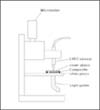Abstract
Objectives
The aim of study was to investigate the effect of flow, specimen geometry and adhesion on the measurement of linear polymerization shrinkage of light cured composite resins using linear shrinkage measuring device.
Methods
Four commercially available composites - an anterior posterior hybrid composite Z100, a posterior packable composite P60 and two flowable composites, Filtek flow and Tetric flow - were studied. The linear polymerization shrinkage of composites was determined using 'bonded disc method' and 'non-bonded' free shrinkage method at varying C-factor in the range of 1~8 by changing specimen geometry. These measured linear shrinkage values were compared with free volumetric shrinkage values.
The viscosity and flow of composites were determined and compared by measuring the dropping speed of metal rod under constant load.
Results
In non-bonded method, the linear shrinkage approximated one third of true volumetric shrinkage by isotropic contraction. However, in bonded disc method, as the bonded surface increased the linear shrinkage increased up to volumetric shrinkage value by anisotropic contraction. The linear shrinkage value increased with increasing C-factor and approximated true volumetric shrinkage and reached plateau at about C-factor 5~6. The more flow the composite was, reduced linear shrinkage was measured by compensation radial flow.
Figures and Tables
Fig. 1-b
The geometry of composite specimen sandwiched between two glass plates. Polymerization shrinkage creates axial (vertical) and radial (horizontal) contraction of the specimen.

Fig. 3
Linear polymerization shrinkage of composites measured using bonded disc method. The linear shrinkage value increased with increasing C-factor and approximated volumetric shrinkage and reached plateau at about C-factor 5~6.
a) Linear shrinkage of Z1 as a function of C-factor.
b) Linear shrinkage of P6 as a function of C-factor.
c) Liner shrinkage of FF as a function of C-factor.
d) Linear shrinkage of TF as a function of C-factor.

Fig. 4
Linear polymerization shrinkage of composites measured using non-bonded disc method with Vaseline. The linear shrinkage is not affected by specimen diameter and is approximated the theoretical linear shrinkage value calculated from true volumetric shrinkage value.
a) Linear shrinkage of Z1 as a function of specimen geometry.
b) Linear shrinkage of P6 as a function of specimen geometry.
c) Liner shrinkage of FF as a function of specimen geometry.
d) Linear shrinkage of TF as a function of specimen geometry.

References
1. Lai JH, Johnson AE. Measuring polymerization shrinkage of photo activated restorative materials by a water filled dilatometer. Dent Mater. 1993. 9:139–143.

2. Sakaguchi RL, Sasik CT, Bunczak MA, Douglas WH. Strain gauge method for measuring polymerization contraction of composite restoratives. J Dent. 1991. 19:312–316.

3. Penn RW. A recording dilatometer for measuring polymerization shrinkage. Dent Mater. 1986. 2:78–79.

4. Rees JS, Jacobsen PH. The polymerization shrinkage of composite resins. Dent Mater. 1989. 5:41–44.

5. Sakaguchi RL, Berghe HX. Reduced light energy density decreases post gel contraction while maintaining degree of conversion in composites. J Dent. 1998. 26:695–700.

6. Suh BI, Feng L, Wang Y, Cripe C, Cincione F, de Rjik W. The effect of the pulse delay cure technique on residual strain in composites. Compend Contin Educ Dent. 1999. 20:2 Suppl. 4–14.
7. Silikas N, Eliades G, Watts DC. Light intensity effects on resin composite degree of conversion, shrinkage strain. Dent Mater. 2000. 16:292–296.

8. Cook WD, Forrest M, Goodwin AA. A simple method for the measurement of polymerization shrinkage in dental composites. Dent Mater. 1999. 15:447–449.

9. Puckett AD, Smith R. Method to measure the polymerization shrinkage of light cured composites. J Prosthet Dent. 1992. 68:56–58.

10. de Gee AJ, Feilzer AJ, Davidson CL. True linear polymerization shrinkage of unfilled resins, composites determined with a linometer. Dent Mater. 1993. 9:11–14.

11. Venhoven BAM, de Gee AJ, Davidson CL. Polymerization contraction, conversion of light-curing BisGMA-based methacryate resins. Biomaterials. 1993. 14(11):871–875.

12. Feilzer AJ, de Gee AJ, Davidson CL. Curing contraction of composites, glass ionomer cements. J Prosthet Dent. 1988. 59:297–300.
13. Fano V, Ortalli I, Pizzi S, Bonanini M. Polymerization shrinkage of microfilled composites determined by laser beam scanning. Biomaterials. 1997. 18:467–470.

14. Watts DC, Marouf AS. Optimal specimen geometry in bonded-disc shrinkage-strain measurements on light-cured biomaterials. Dent Mater. 2000. 16:447–451.

15. Watts DC, Cash AJ. Determination of polymerization shrinkage kinetics in visible-light-cured materials: methods development. Dent mater. 1991. 7:281–287.

16. Feilzer AJ, de Gee AJ, Davidson CL. Increased wall-to-wall curing contraction in thin bonded resin layers. J Dent Res. 1989. 68:48–50.

17. Lee IB. A new method - Real time measurement of the initial dynamic volumetric shrinkage of composite resins during polymerization. J Korean Acad Conserv Dent. 2001. 26:134–140.
18. Opdam NJM, Roeters JJM, Peters TCRB, et al. Consistency of resin composites for posterior use. Dent Mater. 1996. 12:350–354.

19. Bayne SC, Thompson JY, Swift EJ, et al. A characterization of first-generation flowable composites. JADA. 1998. 129:567–577.

20. Labella R, Lambrechts P, van Meerbeek B, Vanherle G. Polymerization shrinkage, elasticity of flowable composites, filled adhesives. Dent Mater. 1999. 15:128–137.

21. Lee IB, Son HH, Um CM. Rheologic properties of flowable, conventional hybrid, condensable composite resins. Dent Mater. 2003. 19:298–307.

22. Tyas MJ, Jones DW, Rizkalla AS. The evaluation of resin composite consistency. Dent Mater. 1998. 14:424–428.

23. Feilzer AJ, de Gee AJ, Davidson CL. Setting stress in composite resin in relation to configuration of the restoration. J Dent Res. 1987. 66:1636–1639.

24. Watts DC, Al Hindi A. Intrinsic 'soft-start' polymerization shrinkage kinetics in a acrylate-based resin composite. Dent Mater. 1999. 15:39–45.

25. Barnes HA, Hutton JF, Walters K. An introduction to rheology. 1989. 1st ed. Amsterdam: Elsevier Science Publishing co.




 PDF
PDF ePub
ePub Citation
Citation Print
Print










 XML Download
XML Download